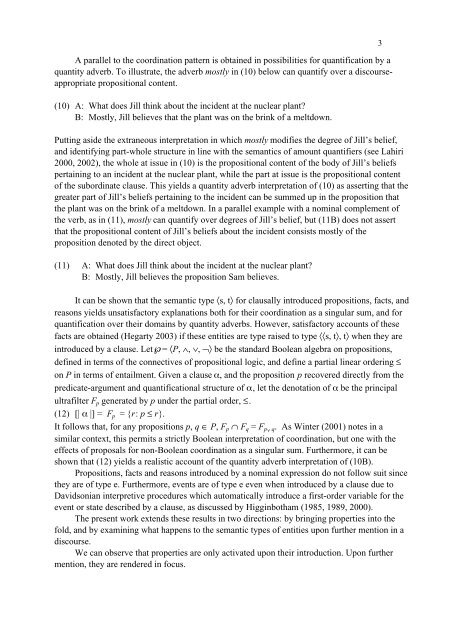SemPrag03.Progr.pdf - Institut für Linguistik/Germanistik - Universität ...
SemPrag03.Progr.pdf - Institut für Linguistik/Germanistik - Universität ...
SemPrag03.Progr.pdf - Institut für Linguistik/Germanistik - Universität ...
You also want an ePaper? Increase the reach of your titles
YUMPU automatically turns print PDFs into web optimized ePapers that Google loves.
A parallel to the coordination pattern is obtained in possibilities for quantification by a<br />
quantity adverb. To illustrate, the adverb mostly in (10) below can quantify over a discourseappropriate<br />
propositional content.<br />
(10) A: What does Jill think about the incident at the nuclear plant?<br />
B: Mostly, Jill believes that the plant was on the brink of a meltdown.<br />
Putting aside the extraneous interpretation in which mostly modifies the degree of Jill’s belief,<br />
and identifying part-whole structure in line with the semantics of amount quantifiers (see Lahiri<br />
2000, 2002), the whole at issue in (10) is the propositional content of the body of Jill’s beliefs<br />
pertaining to an incident at the nuclear plant, while the part at issue is the propositional content<br />
of the subordinate clause. This yields a quantity adverb interpretation of (10) as asserting that the<br />
greater part of Jill’s beliefs pertaining to the incident can be summed up in the proposition that<br />
the plant was on the brink of a meltdown. In a parallel example with a nominal complement of<br />
the verb, as in (11), mostly can quantify over degrees of Jill’s belief, but (11B) does not assert<br />
that the propositional content of Jill’s beliefs about the incident consists mostly of the<br />
proposition denoted by the direct object.<br />
(11) A: What does Jill think about the incident at the nuclear plant?<br />
B: Mostly, Jill believes the proposition Sam believes.<br />
It can be shown that the semantic type 〈s, t〉 for clausally introduced propositions, facts, and<br />
reasons yields unsatisfactory explanations both for their coordination as a singular sum, and for<br />
quantification over their domains by quantity adverbs. However, satisfactory accounts of these<br />
facts are obtained (Hegarty 2003) if these entities are type raised to type 〈〈s, t〉, t〉 when they are<br />
introduced by a clause. Let℘= 〈P, ∧, ∨, ¬〉 be the standard Boolean algebra on propositions,<br />
defined in terms of the connectives of propositional logic, and define a partial linear ordering ≤<br />
on P in terms of entailment. Given a clause , and the proposition p recovered directly from the<br />
predicate-argument and quantificational structure of , let the denotation of be the principal<br />
ultrafilter F p generated by p under the partial order, ≤.<br />
(12) [| |] = F p = {r: p ≤ r}.<br />
It follows that, for any propositions p, q ∈ P, F p ∩ F q = F p q . As Winter (2001) notes in a<br />
similar context, this permits a strictly Boolean interpretation of coordination, but one with the<br />
effects of proposals for non-Boolean coordination as a singular sum. Furthermore, it can be<br />
shown that (12) yields a realistic account of the quantity adverb interpretation of (10B).<br />
Propositions, facts and reasons introduced by a nominal expression do not follow suit since<br />
they are of type e. Furthermore, events are of type e even when introduced by a clause due to<br />
Davidsonian interpretive procedures which automatically introduce a first-order variable for the<br />
event or state described by a clause, as discussed by Higginbotham (1985, 1989, 2000).<br />
The present work extends these results in two directions: by bringing properties into the<br />
fold, and by examining what happens to the semantic types of entities upon further mention in a<br />
discourse.<br />
We can observe that properties are only activated upon their introduction. Upon further<br />
mention, they are rendered in focus.<br />
3

















